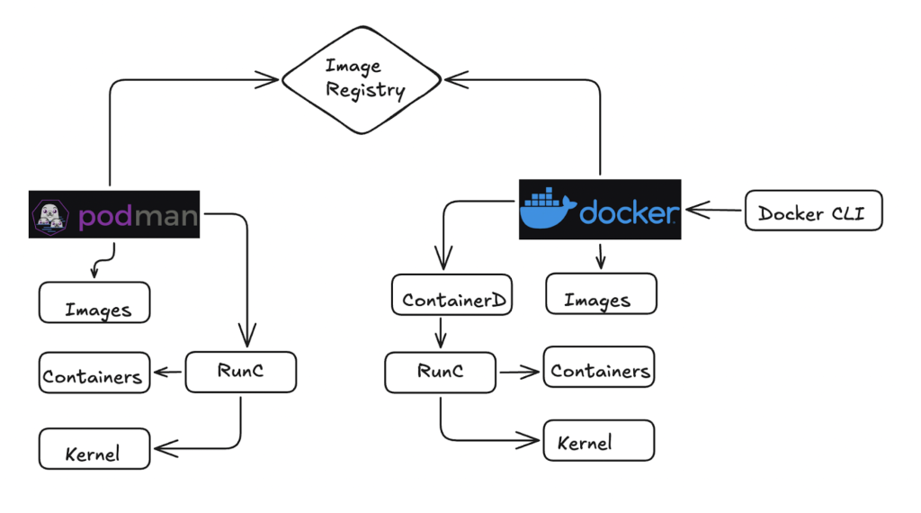Docker vs Podman: A comprehensive comparison
Introduction
Containers have transformed the way we build, ship, and run applications. For a long time, Docker has been the go-to solution for containerization, setting the standard across the industry. However, Podman has gained attention as a strong alternative, offering solutions to some of Docker’s architectural challenges.
In this blog, we’ll take a closer look at how Docker and Podman compare, explore their key differences, and walk through practical examples and real-world scenarios where each tool shines.
Table of Contents
- Overview: Docker vs Podman
- Architecture Differences
- Security Comparison
- Performance Analysis
- Hands-On: Basic Container Operations
- Migration from Docker to Podman
- Pros and Cons
- Conclusion
Overview: Docker vs Podman
Docker
- Created: 2013 by Solomon Hykes
- Architecture: Client-server model with Docker daemon
- Root Requirement: Requires root privileges
- OCI Compliance: Yes
- Company: Docker Inc.
Podman:
- Created: 2018 by Red Hat
- Architecture: Daemonless, fork-exec model
- Root Requirement: Supports rootless containers
- OCI Compliance: Yes
- Company: Red Hat (Open Source)
Architecture Differences
Docker Architecture:
- Client (docker CLI) → Docker Daemon → Containerd → RUNC → Container
Podman Architecture:
- Podman CLI → conmon → runc → Container
Key Difference:
- Podman eliminates the need for a central daemon,
- Podman is more secure and reduces the attack surface

Docker vs Podman
Security Comparison
Docker Security Concerns:
- Root Daemon: Docker daemon runs as root, creating security risks
- Single Point of Failure: If daemon is compromised, all containers are at risk
- Privileged Access: Requires sudo for most operations
Podman Security Advantages:
- Rootless Containers: Can run containers without root privileges
- No Daemon: Eliminates central point of attack
- User Namespace: Better isolation between host and container
Performance Analysis
Resource Usage:
- Docker: Higher memory footprint due to daemon
- Podman: Lower overhead, no persistent daemon
Startup Time:
- Docker: Faster for multiple containers (daemon already running)
- Podman: Slight overhead for first container, but no daemon startup cost
Hands-On: Basic Container Operations
Installing Podman:
- https://podman.io/docs/installation
Operation |
Docker |
Podman |
| Pull Container | docker pull nginx | podman pull nginx |
| Run Container | docker run -d nginx | podman run -d nginx |
| List Containers | docker ps -a | podman ps -a |
| Stop Container | docker stop <container id> | podman stop <container id> |
| Remove Container | docker rm <container id> | podman rm <container id> |
| List Images | docker images | podman images |
| Remove Image | docker rmi <image> | podman rmi <image> |
Practical Example: Running a Web Server
With Docker:
# Run Nginx web server docker run -d --name nginx-docker -p 8080:80 nginx:latest # Check container status docker ps # View logs docker logs nginx-docker # Stop and remove docker stop nginx-docker docker rm nginx-docker
With Podman:
# Run Nginx web server podman run -d --name nginx-podman -p 8081:80 nginx:latest # Check container status podman ps # View logs podman logs nginx-podman # Stop and remove podman stop nginx-podman podman rm nginx-podman
Migration from Docker to Podman
- Alias Method (Quick Start):
# Add to your shell profile (.bashrc, .zshrc) alias docker=podman alias docker-compose=podman-compose # Most Docker commands will work immediately docker run hello-world # Actually runs: podman run hello-world
- Dockerfile Compatibility:
# Most Dockerfiles work without modification: # Build with Docker docker build -t myapp . # Build with Podman (same Dockerfile) podman build -t myapp .
- Volume Migration:
# Export Docker volume docker run --rm -v myvolume:/data -v $(pwd):/backup alpine \ tar czf /backup/myvolume.tar.gz -C /data . # Import to Podman podman volume create myvolume podman run --rm -v myvolume:/data -v $(pwd):/backup alpine \ tar xzf /backup/myvolume.tar.gz -C /data
- Network Migration:
# Docker network docker network create mynetwork # Podman network podman network create mynetwork
- Registry Migration:
# Pull from Docker Hub with Podman podman pull docker.io/library/nginx # Configure registries echo 'unqualified-search-registries = ["docker.io"]' >> ~/.config/containers/registries.conf
Rootless Container Demo
# Run container as non-root user with Podman podman run -it --rm alpine sh # Inside container, check user whoami # Shows non-root user id # Shows user ID mapping # Try to access host resources (should fail) ls /proc/1/ # Limited access to host processes
Pros and Cons
Docker:
- Pros: Mature ecosystem – Extensive documentation – Large community – Docker Desktop GUI – Better Windows support – Established in enterprise
- Cons: Security concerns (root daemon) – Resource overhead – Single point of failure – Licensing changes – Requires Docker Desktop on macOS/Windows
Podman:
- Pros: Rootless containers – No daemon required – Better security model – Lower resource usage – Pod support (like Kubernetes) – Drop-in Docker replacement – Open source (Apache 2.0)
- Cons: Smaller community – Less mature ecosystem – Limited Windows support – Learning curve for Docker users – Some Docker Compose features missing
Conclusion
Both Docker and Podman are excellent containerization tools, each with distinct advantages:
Choose Docker if: You need mature ecosystem support – Working primarily on Windows/macOS – Require Docker Desktop features – Have existing Docker infrastructure – Need extensive third-party integrations
Choose Podman if: Security is a top priority – Working in Linux environments – Want rootless containers – Prefer open-source solutions – Need Kubernetes-like pod management – Want to reduce resource overhead
Key Takeaways
- Compatibility: Podman provides excellent Docker compatibility
- Security: Podman’s rootless architecture offers better security
- Performance: Podman generally uses fewer resources
- Ecosystem: Docker has a more mature ecosystem
- Migration: Moving from Docker to Podman is relatively straightforward
Recommendations
- New Projects: Consider Podman for better security and performance
- Existing Projects: Docker migration can be done gradually
- Enterprise: Evaluate based on security requirements and existing infrastructure
- CI/CD: Podman offers advantages in pipeline security
- Development: Both tools work well for local development



